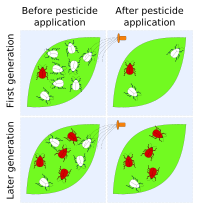
Photo from wikipedia
Abstract BACKGROUND The sustainable control of the Mediterranean fruit fly, Ceratitis capitata (Wiedemann), is compromised by the development of resistance to malathion and lambda‐cyhalothrin in Spanish field populations. At present,… Click to show full abstract
Abstract BACKGROUND The sustainable control of the Mediterranean fruit fly, Ceratitis capitata (Wiedemann), is compromised by the development of resistance to malathion and lambda‐cyhalothrin in Spanish field populations. At present, field populations remain susceptible to spinosad. However, the resistant strain JW‐100s has been obtained under laboratory selection with spinosad, and resistance has been associated with the presence of different mutations causing truncated transcripts of the α6 subunit of the nicotinic acetylcholine receptor (nAChRα6). RESULTS An F1 screen assay followed by the molecular characterization of surviving flies has been used to search for spinosad‐resistant alleles in field populations. Two different resistant alleles giving rise to truncated isoforms of Ccα6 have been identified, which corresponds to an estimated allelic frequency of at least 0.0023–0.0046. The fitness values of the resistant nAChRα6 alleles found in the laboratory strain JW‐100s were estimated to be 0.4 for RR and 0.2 for SR. Mathematical modelling predicted that spinosad‐resistant alleles will rapidly decline over time in field populations if their fitness cost was the same as estimated for laboratory‐resistant alleles. However, they are predicted to increase in the field if their fitness cost is lower and resistance management strategies are not implemented. CONCLUSION Spinosad‐resistant alleles have been detected in field populations for the first time. Our modelling simulations indicate that the best option to delay the appearance of spinosad resistance would be its rotation with other insecticides without cross‐resistance. The integrated F1 screen/molecular genetic analysis presented here can be used for future monitoring studies. © 2020 The Authors. Pest Management Science published by John Wiley & Sons Ltd on behalf of Society of Chemical Industry.
Journal Title: Pest Management Science
Year Published: 2020
Link to full text (if available)
Share on Social Media: Sign Up to like & get
recommendations!